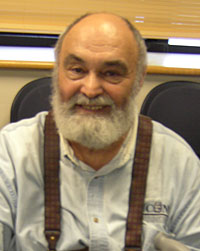Date: 2010-03-13 Time: 07:00 - 09:00 US/Pacific (1 decade 4 years ago)
America/Los Angeles: 2010-03-13 07:00 (DST)
America/New York: 2010-03-13 10:00 (DST)
America/Sao Paulo: 2010-03-13 11:00
Europe/London: 2010-03-13 14:00
Asia/Colombo: 2010-03-13 19:30
Australia/Sydney: 2010-03-14 01:00 (DST)
Where: Online Video Conference
This video conference used DimDim, now a private company.
The meeting can be replayed by clicking this link:
watch the meeting recording
Description
It is known that some well documented experimental effects are not explained by modern electrodynamics. Some of them were detected already by Gauss, Riemann, Weber, Ampere, Whittaker. These authors also proposed formulae witch are not covered by modern electrodynamics. There are some facts of this kind in today practice as well. Apparently the most vivid example is cluster-effect. It seems evident that electrons moving in a beam must be dispersed by Coulomb force. But actually they are gathered into clusters. No accelerators could work without cluster-effect, but it has no theoretical explanation today. The book is a collection of this author previous publications devoted to analysis of the connections between electricity and gravity. In historical review attention is concentrated on the questions to which modern electrodynamics proposes unsatisfactory answers or even mathematical mistakes take place.
Equations generalizing traditional Maxwell equations and Lorentz force formula are proposed in sections 2, 3, 4. The following five sections are devoted to examples. It is shown that Generalized Electrodynamics covers all the formulae mentioned above. Some predictions which must be verified experimentally in future are formulated. Section 10 is devoted to conservation laws. The problem of the third Newton law validity in Generalized Electrodynamics is investigated. It is known that Lorentz force formula does not satisfy the third Newton law.
Connection with gravity is formulated as some appendices. Appendix 1 is devoted to the problem of dimensions for electrodynamics values. Mechanical dimensions are introduced for them. It turns out that electric field has dimension of velocity, i.e. it is velocity field. It is well known that gravity has dimension of acceleration, i.e. it is acceleration field. Therefore conjecture appears that gravity must be described bi Maxwell type equations in which the first order time derivative is changed for the second order one. This hypothesis is formulated in appendices 2 and 3. Appendix 4 is actually thing for anticipation. The fact is that conservation laws similar to the laws in electrodynamics are valid for gravity. Mathematical formulation of conservation laws in electrodynamics just as in thermodynamics and hydrodynamics are expressed by continuity equation which depends on the velocity with which water penetrates a surface. But such description is not sufficient for accelerated processes. Appendix 4 is called �he Second Continuity Equation� It enables to analyze accelerated processes.



